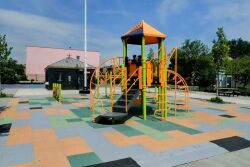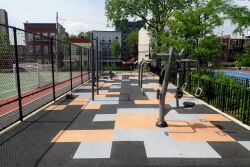Agnes Haywood Playground
Agnes Haywood Playground
This playground is named to honor local resident and civic activist Agnes Haywood (1907-1983). Haywood was born in New York City and graduated from Julia Richman High School. After earning a degree from the New York Academy of Business, she accepted a civil service position with the Board of Child Welfare.
In 1953, Haywood and her family moved to the Williamsbridge section of the Bronx. Haywood became active in the St. Augustine Presbyterian Church in the South Bronx, and when her children began school, she became involved with the parent-teacher association at P.S. 23 on Washington Avenue, organizing shows to raise funds for the school. Haywood went on to work with Bronx Borough President Robert Abrams and City Council Majority Leader Thomas J. Cuite, as well as Council Member Jerry L. Crispino on behalf of her community.
Haywood helped to organize the Williamsbridge Chapter of the National Association for the Advancement of Colored People (NAACP), becoming one of its charter members. At the time of her death in 1983, she was president of the Williamsbridge Chapter of the National Council of Negro Women (NCNW). When a small earthquake shook the Northeast the morning of the playground’s dedication in 1985, her friends and family, remembering her energy and determination, remarked that it was Haywood waking them up to make sure they attended the event.
The origin of the name Williamsbridge has been debated. In the early 18th century, a man named John Williams owned a farm on the east bank of the Bronx River. Although Williams is credited with building the first bridge over the Bronx River, some historians dispute the matter, noting that he was one of several men hired by other landowners who sought an easier route across the river. But Williams’s farm was the nearest to the bridge, and by the time of the American Revolution, the structure was widely known as Williams’ Bridge. By the 19th century a settlement of houses had sprung up around the bridge, taking the name Williamsbridge. The area remained fairly rural until 1841, when the New York and Harlem Railroad built a line connecting the area to Manhattan. The neighborhood became truly urban in the 1920s, after the Interborough Rapid Transit (IRT) extended its subway route up to White Plains Road.
This site opened in 1954 as the playground for Olinville Junior High School. In 1985, Parks Commissioner Stern named the playground in remembrance of Agnes Haywood. In 1988, Council Member Crispino funded a $824,500 renovation that remodeled the public restroom, planted trees and shrubs, and installed new benches, drinking fountains, game tables, bleachers and play equipment. A $285,000 project funded in 1997 by Council Member Lawrence A. Warden added play equipment and other improvements. Serving the both the school community and the community at large, the playground serves as a fitting tribute to its namesake.
Check out your park's Vital Signs
Clean & Safe
Green & Resilient
Empowered & Engaged Users
Share your feedback or learn more about how this park is part of a
Vital Park System









